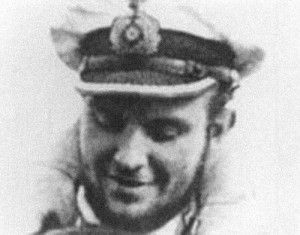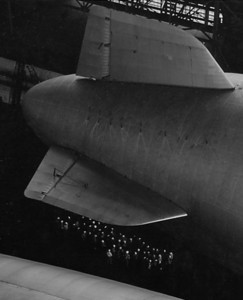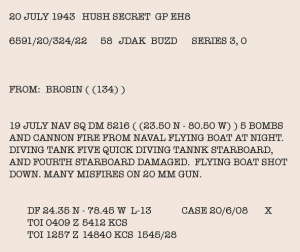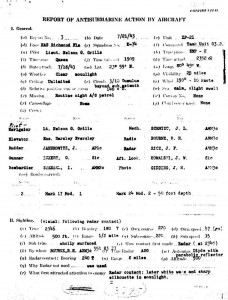Published on July 19, 2012
The K-74 Attacks
Hidden in the darkness of the night, the US Navy blimp K-74 throttled up and angled downward to 250 feet of altitude and into an attack pass against the German submarine U-134. Rapidly, it accelerated to 55 knots airspeed. As the blimp crossed the usual attack range of 500 yards, it was still undetected and Lt. Grills ordered the gunner to hold his fire. At 200 yards, Lt. Grills ordered Gunner S1c G. Eckert (an expert who had previously been a former gunnery instructor) to open fire with the cab-mounted .50 cal Browning. Meanwhile, Bombardier AMM2c Isadore Stessel armed his depth charges and focused on his bomb sight — most likely in the excitement, he improperly set the selector, a common error with the Type L-21A Bomb Release mechanism.

As the blimp pressed in, the crew of the U-134 tried to man the U-Boat’s machine gun, but Eckert’s accurate .50 cal fire raked the sub and surrounding water. The sub’s crew returned intermittent bursts nonetheless, prompting the K-74’s Radioman Bourne to repeatedly transmit the short code for ‘am being fired upon’ — “OFU — OFU — OFU — OFU” (in fact, 16 times as the blimp made its attack pass). Somehow, his messages were not received by NAS Richmond, but were luckily overheard by another airship, K-32, which relayed the signals.
When the K-74 passed overhead, its .50 cal Browning could no longer depress sufficiently to fire upon the U-Boat. Up to that point, Eckert had fired 100 rounds with the Browning with excellent effect, suppressing return fire and damaging the sub as well, the heavy .50 cal bullets piercing the starboard rear side of the number four ballast tank and damaging the number five quick diving tank. Now it was bombardier AMM2c Stessel’s battle to fight.
Depth Charge Failure
With the blimp flying in a perfect overhead attack pass, AMM2c Isadore Stessel flicked the switches to drop his depth charges. The line up was perfect and there was little chance of missing. He hit the switch repeatedly — yet nothing happened. Most likely due to having improperly set the L-21A selector switch, the ordnance instead remained hung up in the bomb bay. Now, rather than culminating a perfect attack pass with the sinking the U-Boat, the K-74 was now passing overhead at 55 knots — a lumbering, defenseless and huge target.

With the cessation of the suppressive fire from Eckert’s .50 cal Browning, the German U-Boat commander ordered his crew to fire for effect. The gunners opened fire with the sub’s 2 cm machine gun. The blimp was so close that they couldn’t miss — just 250 feet straight overhead. As it passed, the German gunners raked the blimp canopy and cab with unanswered and deadly fire. One of the engines was hit and caught fire. The flight controls in the cab were shot away. The canopy was fatally holed and helium began escaping. As the 250 foot long bulk of the blimp motored away, it was out of control. It pitched up and climbed to 1,000 feet of altitude before the loss of helium caused it to settle back down into the water, striking tail first, its left engine still running as the blimp crashed into the water.

Expecting the K-74 to sink rapidly, the crew (miraculously with only minor injuries) abandoned the airship in haste. In the rush to exit the cab, AMM2c Isadore Stessel would make yet another fatal error — he would neglect to take the life raft out of the blimp. It appears everything went wrong that night for Stessel. There was little time, however, and the crew knew that once the blimp sank, its depth charges would explode. They swam quickly away into the night.
Somehow, the blimp didn’t sink. Instead, it hung low, floating hard against the sea for another eight hours. The U-134 pulled alongside in the darkness of the night, retrieved some equipment onto its decks for evaluation and photographed the gear before sailing away into the darkness. With the blimp still afloat, the crew swam back and clung to the collapsed canopy through the rest of the night.

After the Battle
In the wake of its encounter with the K-74, the U-134 headed quickly away from the scene. With its position likely reported, the sub’s commander, Hans-Günther Brosin, knew that other aircraft and ships would soon be closing in. From the recorded position reports, it appears that the U-Boat commander first headed northwest to the shores just off Homestead to dodge detection by the American ships. Then he turned for a run directly east to escape back through the passage north of Andros and Nassau two days later. The U-Boat made a clean getaway and headed east back across the Atlantic.
As for the K-74’s crew, they were first spotted from an aircraft and then later rescued the following day by the US Navy destroyer USS Dahlgren and the Submarine Chaser USS SC-657, both of which had been dispatched to the area to search for the missing aircrew and submarine.

Of the ten crew on board, nine would survive the long hours in the water. Exhausted and suffering the effects of hypothermia, the tenth man, the ill-fated bombardier Isadore Stessel, would be attacked by a shark that appeared suddenly just as the rescuing ship drew near. In the entire war, he was the only member of the US Navy’s airship force to die from enemy action.
The aircrew would file their formal attack report three days later on July 21, describing the circumstances of the action. The Navy’s own messages would state clearly, “The action of Lieutenant Grills in pressing home his attack in the face of enemy fire is in keeping with Naval tradition.”
In later years, Lt. Grills would retire from the Naval Reserve with the rank of Commander. Having been an attorney since the late 1930s, he would teach at Indiana University Law School for a time before being elected to the State Senate where served with distinction until 1967. Before he passed away in 2005, he demonstrated the same decisiveness that had led to his decision to attack the U-134 when he said, “I am on my way, but I have no arguments with anyone. I know no one who has any arguments with me… but then again, if they do have arguments, they better sharpen them up.”
One More Bit of Aviation Trivia
The advent of long range patrol aircraft with on board radar systems made the survival of U-Boats at sea very difficult and was the key to turning the tide of the Battle of the Atlantic. For the U-134, this ninth patrol would be its last. After sailing back across the Atlantic Ocean, the U-Boat would rendezvous with another submarine, the U-170, off the coast of Portugal. Its photos of the K-74 wreckage were offloaded and other supplies were brought on board. Shortly thereafter, on August 24, the U-Boat was spotted yet again by an aerial radar system off Cape Finisterre mounted on board a Vickers Wellington flying from RAF Squadron No. 179. The Wellington’s attack pass would drop six depth charges, sinking the sub with the loss of its entire crew of 48 men.


Hello,
I believe my father, Jerold Marlin Gidding was on K-74 when it was shot down. He passed in 1990 and only told me bits of the story….
Any information and links would be appreciated.
David
I am researching the K-74 battle for my Master’s Thesis. Your father is listed on the Action Report as being on the airship assigned to “Photo” as an ARM3/c (if I am not mistaken, that stands for Airship Radioman/Gunner 3rd Class). If I can answer any specific questions for you, please feel free to ask.
Bernard Johns
My father was in a blimp crash in the same area. His name was Robert Markley and I believe they called him Pappy. I do not know if it is the same ship or not because he would hardly talk about it. I still have the bag the Red Cross gave him with the inscription ” American red Cross Key West, FL” on it. I would appreciate any information you could supply.
Thank you,
Jim Markley
301 934-2205
My grandfather was on the k-74 and is still living in tip top shape! Rice. Love hearing this story.
Isadore “Izzy” Stessel was my mother’s cousin. Technically, he was the nephew of her step-father, Abe Stessel, so I guess that makes him her step-cousin.
I heard this story a lot when I was growing up. Coupled with the movie Jaws, which came out during formative years, this made me incredibly scared of sharks! Snorkeling is an unnerving experience…